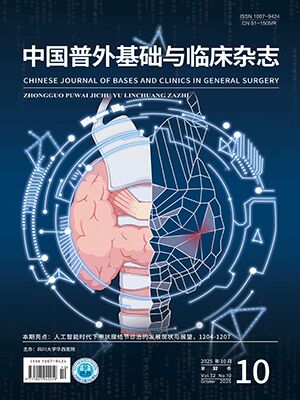Objective To explore the clinical significance on protection of parathyroid and recurrent laryngeal nerve (RLN) by meticulous capsular dissection and exposure of RLN in thyroid lobectomy.
Methods Clinical data of 452 patients who underwent thyroid lobectomy by meticulous capsular dissection and exposure of RLN in our hospital from Jan. 2010 to Dec. 2012 were retrospectively analyzed.
Results All of the 452 cases underwent thyroid lebectomy successfully without death, and the operative time was 45-110min (average 60 min), the blood loss was 5-100mL (average 20mL). The pathological results showed that there were thyroid adenoma in 193 cases, nodular goiter in 175 cases, Hashimoto thyroiditis in 38 cases, thyroid cancer in 46 cases. After operation, 4 cases suffered RLN injury, 1 of the 4 cases recovered after removal of drainage tube, and other 3 cases recovered during 0.5 to 3.0 months. In addition, 2 cases suffered laryngeal nerve injury whose symptoms disappearred within 1 week, 5 cases suffered parathyroid founctional damage without permanent hypocalcemia whose symptom had kept 1-5 days after treatment. Three cases were reoperated because of bleeding, including branch of anterior venous bleeding in 1 case, thyroid side arterial tube bleeding in 1 case, and thyroid stump bleeding in 1 case. Twenty one cases suffered hypothyroidism in 1 month after operation, and no recurrence happened during the followed up period.
Conclusions Meticulous capsular dissection can effectively protect function of parathyroid and reduce the injury probability of RLN. Exposure of RLN is safe and feasible, which plays an important role in avoiding serious RLN injury.
Citation: ZHOU Longxiang,YU Dong,XU Jun,SHEN Zhong,WU Zhongxin,.. Clinical Analysis of Thyroid Lobectomy by Meticulous Capsular Dissection and Exposure of Recurrent Laryngeal Nerve in 452 Cases. CHINESE JOURNAL OF BASES AND CLINICS IN GENERAL SURGERY, 2013, 20(6): 638-642. doi: Copy
Copyright © the editorial department of CHINESE JOURNAL OF BASES AND CLINICS IN GENERAL SURGERY of West China Medical Publisher. All rights reserved
-
Previous Article
Real-time Three Dimensional Echocardiography Guided Closure of Atrial Septal Defect through a RightMinithoracotomy in Comparison with Traditional Surgical Repair under Cardiopulmonary Bypass -
Next Article
Diagnosis and Treatment of Acute Stanford Type A Aortic Dissection during Pregnancy




